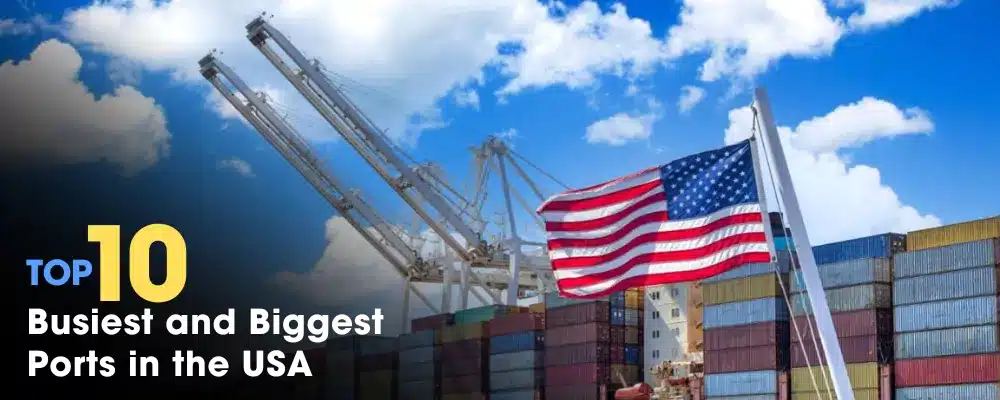

Table of Contents
Sea Ports in the USA
The US is one of the world’s leading economies that relies to a large extent on sophisticated transport and logistics infrastructure to maintain domestic and international trade. Among them are a set of ports integral to the country, serving as major entry and exit points for products. They provide much more than entry points but serve as dynamic ecosystems fostering growth, innovation, and global trade.
With the volume of trade that is done by sea, an examination of the largest and busiest ports in the United States reveals some very valuable information on the economy, strategies in business, and infrastructure of transport.
These seaports move millions of tonnes of cargo annually, connecting companies in the United States to global markets and playing an integral part in the supply chain.
The next post will look into the top 10 largest and busiest ports in the US, including those supporting the nation in terms of its economy, while at the same time providing innumerable jobs, encouraging technical developments in the process, and assuring efficient commodities transits around the world. Examining these main hubs shows their tremendous impact on both the US and the global economy.
These seaports move millions of tonnes of cargo annually, connecting companies in the United States to global markets and playing an integral part in the supply chain.
The next post will look into the top 10 largest and busiest ports in the US, including those supporting the nation in terms of its economy, while at the same time providing innumerable jobs, encouraging technical developments in the process, and assuring efficient commodities transits around the world. Examining these main hubs shows their tremendous impact on both the US and the global economy.

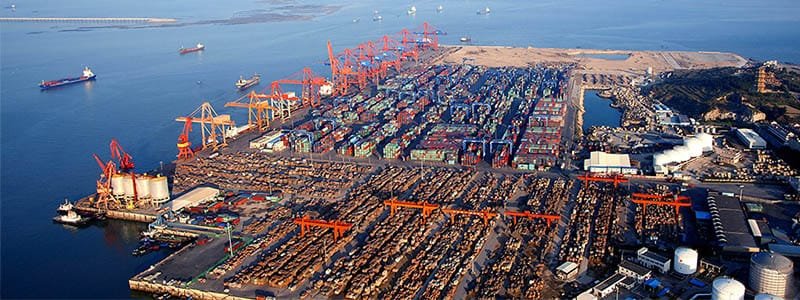
What Makes a Port Busy?
The US is one of the world’s leading economies that relies to a large extent on sophisticated transport and logistics infrastructure to maintain domestic and international trade. Among them are a set of ports integral to the country, serving as major entry and exit points for products. They provide much more than entry points but serve as dynamic ecosystems fostering growth, innovation, and global trade.
With the volume of trade that is done by sea, an examination of the largest and busiest ports in the United States reveals some very valuable information on the economy, strategies in business, and infrastructure of transport.
These seaports move millions of tonnes of cargo annually, connecting companies in the United States to global markets and playing an integral part in the supply chain.
The next post will look into the top 10 largest and busiest ports in the US, including those supporting the nation in terms of its economy, while at the same time providing innumerable jobs, encouraging technical developments in the process, and assuring efficient commodities transits around the world. Examining these main hubs shows their tremendous impact on both the US and the global economy.

What are the top 10 busiest ports in the US?
Number
Port
TEUs
TEU Change
Total Imports
Total Exports
Key metrics:
1
Port of Los Angeles
California
9
911
159
-14.53%
2
Port of Long Beach
California
9
133
657
-2.67%
3
Port of Houston
Texas
3
974
901
+14%
4
The Northwest Seaport Alliance (Seattle-Tacoma)
3
384
018
-9.43%
1
5
Port of Oakland
California
2
337
125
-4.50%
6
Port of New York and New Jersey
9
493
664
+5.7%
4
7
Port of Savannah
Georgia
5
892
131
+4.97%
8
Port of Virginia
3
695
156
+14.7%
1
9
Port of Charleston
South Carolina
2
853
046
+11.93%
10
Port of Miami
Florida
1
197
644
+19
Number | Port | TEUs | TEU Change | Total Imports | Total Exports | Key metrics: |
1 | Port of Los Angeles | California | 9 | 911 | 159 | -14.53% |
2 | Port of Long Beach | California | 9 | 133 | 657 | -2.67% |
3 | Port of Houston | Texas | 3 | 974 | 901 | +14% |
4 | The Northwest Seaport Alliance (Seattle-Tacoma) | 3 | 384 | 018 | -9.43% | 1 |
5 | Port of Oakland | California | 2 | 337 | 125 | -4.50% |
6 | Port of New York and New Jersey | 9 | 493 | 664 | +5.7% | 4 |
7 | Port of Savannah | Georgia | 5 | 892 | 131 | +4.97% |
8 | Port of Virginia | 3 | 695 | 156 | +14.7% | 1 |
9 | Port of Charleston | South Carolina | 2 | 853 | 046 | +11.93% |
10 | Port of Miami | Florida | 1 | 197 | 644 | +19 |
List of Top 10 Biggest Sea Ports in the USA
1. Port of Los Angeles, California
The Port of Los Angeles is by far the largest and busiest port in the United States, acting as a vital node in international trade, especially with Asia. In 2024, this hub received 10.66 million TEUs of container volume, stressing its capacity to handle such a large amount of goods efficiently. Likewise, there were cargo tonnages amounting to 222 million metric revenue tons handled annually from the port in question, pointing once more to its inestimable value to international commerce.
Until today, the huge 7,500-acre facility accommodates everything, from manufactured goods to perishables, and from terminal and harbor services to shipbuilding, with 1,867 vessels being handled annually-a testament to its capability to serve even the world’s largest trading vessels. Much of this trade is driven by key trading partners like China and Hong Kong, Japan, and South Korea, further emphasizing the strategic value of the port in connecting the U.S. to key Asian markets.
Besides the stellar cargo statistics, of importance is the fact that the Port of Los Angeles serves as a major building block for the economy of Southern California, supporting 1.6 million jobs both directly and indirectly. The economic contribution extends further than at the port itself, touching everything from logistics to manufacturing, helping solidify its status as a driver of growth regionally and nationally.
2. Port of Long Beach, California
The Port of Long Beach in California is one of the busiest and most important ports in the United States and is ranked second after its neighbor, the Port of Los Angeles. Such was its critical role in the global supply chain that it handled 9.13 million TEUs of container volume last 2022. It also processed 78.2 million metric tonnes of cargo, making it, quite obviously, a significant gateway in worldwide trade.
The Port of Long Beach is made up of 3,200 acres and holds 80 cargo berths. This allows processing for different vessel types and cargo and, as such permits the swift process that qualifies this port as a major facility in the United States, taking and sending goods to and from Asia.
The economic contribution of the port is huge, considering that about 370,000 jobs depend directly and indirectly on the facility. These involve broad industries in transportation, logistics, and manufacturing, hence making the Port of Long Beach a very significant contributor to not only regional but also national economies. Its strategic location, complemented by continuous investments in infrastructure and technology, positions it to be one of the main players in the global trade arena and a cornerstone of the U.S. economy.
3. Port of Houston, Texas
The Port of Houston, Texas, is an economic driver not only for the state of Texas but also as a supplier of trade to the world. This comprises 8,200 vessel calls annually and is one of the busiest U.S. ports in cargo tons handled, whose variety is being managed effectively. The exceptional cargo tonnage handled each year by the port, reaching 247 million metric tonnes, highlights its position as an essential domestic and international trade center.
In addition to its deep-water cargo, the Port of Houston is a major inland waterway port, processing 215,000 barges annually. This number of barges is crucial to achieve the movement of commodities through much of interior United States, especially down the Gulf Coast and deep into the centre of the country. Its annual container volume is 1.6 million TEUs, showing how it can process a large amount of diverse cargo efficiently.
The total value that the Port of Houston contributes to Texas’ economy is an astonishing $339 billion. Such immense economic power serves various businesses, from oil to manufacturing to logistics. This makes it a pivotal facility in Texas’ economic development and an asset that plays a major role in the nation’s trade infrastructure.
4. The Northwest Seaport Alliance (Seattle-Tacoma)
The Northwest Seaport Alliance, which includes the ports of Seattle and Tacoma, constitutes an important commercial center in the Pacific Northwest and thus is an important contributor to the United States’ maritime economy. Over the past years, the Alliance has shown its capability to act as a great hub of containerized cargo, since the so-called container volume was 3.38 million TEUs.
It translates into an economic impact contributed by the Alliance, adding a number in excess of $4.3 billion to the area economy each year. The impact varies from transportation and logistics among others, right through manufacturing, and covers the gamut of different industries in support of many varied job types within the region.
Cargo volume within the Alliance remains on the increase-from over 3.3 million TEUs in 2020 to 3,736,206 TEUs in 2021. This steady and upward momentum underlines the strategic importance and relevance of the Alliance to connect U.S. markets with destinations in Asia and elsewhere overseas. While the Northwest Seaport Alliance remains an important actor in the supply chain, it is still playing a vital part in the flow of goods across the Pacific and elsewhere.
5. Port of Oakland, California
It is in the Port of Oakland that commitment to environmental sustainability has been so pre-eminent. This port has instituted a Truck Management Program at the Port, for the purposes of working on reducing emissions, so that it can take care of high cargo throughput with environmental responsibility.
It is also equipped with 27 cranes that indeed are not anything short of an absolute necessity in ensuring timely loading and unloading of large volumes of containerized cargo passing through the port. This infrastructure, combined with its strategic location and focus on sustainability, has primarily enshrined the Port of Oakland as a significant player in regional and international trade.
6. Port of New Jersey and New York
Otherwise known as the Port Authority of New York and New Jersey, the Port of New Jersey and New York is one of the major marine gateways down the East Coast of the United States. In light of the increasing importance of international trade, this port has moved 7.4 million TEUs over the past years, thus emphasizing its status as one of the busiest in the nation.
7. Port of Savannah, Georgia
The state of Georgia owns an important southeastern American hub for marine trade-the so-called Port of Savannah-which is renowned for efficiency with large cargo-handling ability.
It moved 5.76 million TEUs of containerized cargo in 2022, underlining its importance to the volumes moving in international trade.
The infrastructure at the port comprises large deep-water terminals, namely:
Garden City Terminal:
Ocean Terminal
8. Port of Virginia
The Port of Virginia is one of the deep-water marine gateways of commerce on the East Coast and has a significant impact on the economic and trade contributions of the United States. In 2022, the port had handled 3.7 million TEUs of containerized freight against 3.2 million in the previous year, thereby gaining importance in international trade.
The cargo volume is but the tip of the iceberg when it comes to the port’s importance. It generates nearly $92 billion in revenue for the state every year-a sure testament to how important it is as a major economic driver for Virginia.
The Port of Virginia consists of five major terminals, each with state-of-the-art facilities in the efficient handling of virtually any cargo type. These facilities are important features that enable the port to handle such high volumes and variety of cargo.
The port notably provides direct and indirect employment to 397,000 individuals, hence its important generation of regional employment and economic development. In particular, such a huge labor force is involved in many sectors like logistics, transportation, and manufacturing, underlining the great contribution it has to both the local and national economy.
9. Port of Charleston, South Carolina
10. Port of Miami, Florida
In sum, the Port of Miami is much more than just a significant gateway for cargo, but it is also an extremely essential element in regional economic development due to its strategic location and upgraded facilities that already ensure its place in global maritime trade.
Consideration to Select the Best Port For Your Shipment
Some of the most common considerations in the selection of a port of export for your merchandise include the following:
- Proximity: The proximity to your merchandise helps minimize the transportation cost to the port and will not cause delays.
- Infrastructure: Modern facilities and efficient operations are key in ensuring that cargo handling and processing are done without any hitches.
- Connectivity: It ought to link well to the highways, railroads, and airports to ensure easy movement of goods.
- Specialty: Choose a port that has experience with whatever type of cargo you’re moving-be it automobiles, perishables, or even bulk goods.
- Efficiency in Customs: Look for facilities with streamlined customs procedures to cut time and paper work.
- Green Shipping: Consider ports with greener initiatives to cut your carbon footprint.
It is very important to choose a port deliberately for your shipment, as it might have a great impact on your business. There are numerous busy ports in the U.S., each with benefits of its own. To make an informed decision, consider these factors:
Location: The closer to your origin or destination, the lower your transportation costs will be, and the shorter the transit time.
Infrastructure: Identify those that boast of state-of-the art facilities, up-to-date technology in managing cargo more expeditiously.
Transport Links: The ports must be well-connected to high-capacity highways, rail, and airport for smooth forward movement of cargo.
Specific Cargo Needs: Identify whether the consignment is perishable; finished automobiles, bulk cargo, or any other category of cargo to identify which ports handle it better.
Customs Clearance: Speedy customs processing is time-saving and reduces a lot of administrative work.
Sustainability: Take into consideration those ports that are self-declared as sustainable and have in place practices that have minimal environmental impact. Considering these reasons, you will be in a position where you can carefully choose the best port for your shipment; it helps attain efficiency and success in logistics operations.

TopShipping
With years of experience in logistics and freight forwarding, the author is passionate about making shipping smoother and more efficient.
As a leader at TopShipping, they’ve developed a deep understanding of supply chain management, international shipping rules, and creative logistics solutions. They’re driven by a desire to help businesses succeed by delivering reliable, customer-focused services.
Over the years, they’ve also shared their expertise by writing for various industry publications, offering practical tips and insights on the latest trends in logistics. Thanks to their leadership, TopShipping has become a trusted name for companies looking for hassle-free global freight solutions.
Comment Section
Comment
Write your idea about "Top 10 biggest busiest ports in the US"


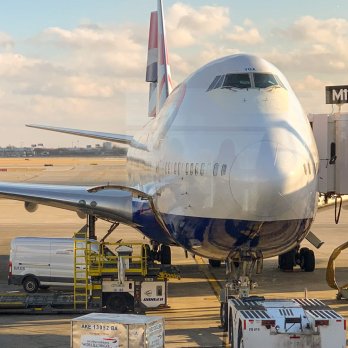



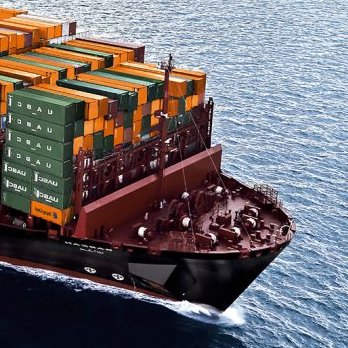
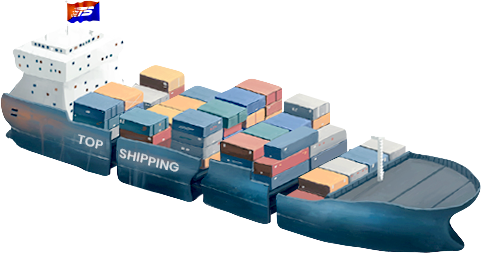
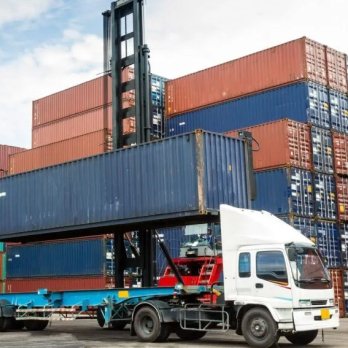







No comments yet.